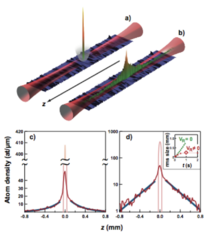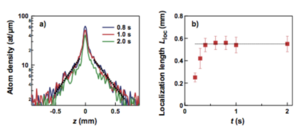L-7: Difference between revisions
| Line 30: | Line 30: | ||
[[File:Localization1DB.png|thumb|left| | [[File:Localization1DB.png|thumb|left|x240px|BCE coondensate confined with an harmonic trap in a 1D disordered geometry. When the trap is removed particles start to spread but remain localized in space.]] | ||
[[File:Localization1dB.png|thumb|left|x140px| | [[File:Localization1dB.png|thumb|left|x140px|Semilog plot of the particle concentration. The exponential decay of the tails is the fingerprint of a finite localization lenght ]] | ||
== The conductance and the diffusive behaviour == | == The conductance and the diffusive behaviour == | ||
Revision as of 16:24, 8 March 2024
Goal : This is the first lecture about the localization. Localization is a wave phenomenon induced by disorder.
The Gaussian packet of free particles: the ballistic behaviour
The Schrodinger equation govern the evolution of the quantum state of a particle in 1D:
Here is the Hamiltonian. For a free particle the potential is absent, . One first look for separable solution, or eigenstates or stationary solutions. These solutions are stationary because if the particle is in an eigenstate, its physical properties are time independent. For a free particle, the separable solutions has the form
Here is a real number. These solutions are delocalized on the entire real axis and they cannot be normalized.
The physical states of the particle can be decomposed on the eigenstate of the Hamiltonian. Indeed, For the superposition principle, any linear combination of separable solution is also a solution of the Schrodinger equation. However this superposed solution are not separable and the particle's properties will evolve in time. Hence, we can costruct a localized wave packet, with the correct normalization:
An example is the Gaussian packet of intial spread :
Challenge: Am I really a pro with Gaussian integrals?
- Initial state . Show that at time , the wave packet and its probability density function are
- Time evolution . We define the spreading speed . Show that the time evolution of the Gaussian wave packet has the form:
- Ballistic Spreading. Show that the Probability density function of the position is
Hence, the particle spreads on a distance
Localization experiment
The conductance and the diffusive behaviour
Ohm's laws characterize electric transport of (good or bad) conductors:
- First law:
Here is the resistence of the sample and is its conductance.\
- Second law
Here are the resistivity and the conductivity. These are material properties, independent of the geometry of the sample These phenomenological laws are a macroscpic manifestation of the diffusive motion of the electrons. From the Drude model we know that disorder is the crucial ingredient to justify the presence of diffusion. ]











![{\displaystyle \psi (x,t)={\frac {e^{-x^{2}/(4a^{2}(1+iv_{s}t))}}{[2\pi a^{2}(1+iv_{s}t)]^{1/4}}}}](https://wikimedia.org/api/rest_v1/media/math/render/svg/e95054f1f4a5b73cf20b31aa9348de5e6d24c135)
![{\displaystyle |\psi (x,t)|^{2}={\frac {e^{-x^{2}/(4a^{2}(1+v_{s}^{2}t^{2}))}}{[2\pi a^{2}(1+v_{s}^{2}t^{2})]^{1/4}}}}](https://wikimedia.org/api/rest_v1/media/math/render/svg/fadce124d5a6081c5b676301c5fadbc5fb50eae6)







